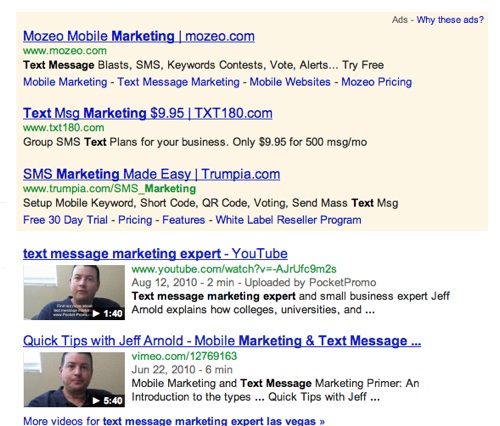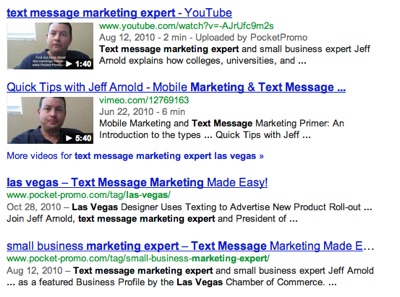Articles and News
EXCLUSIVE DIGITAL MARKETING SERIES: USING VIDEO AND IMAGE MARKETING | January 04, 2012 (0 comments)

The tenth installment of The Centurion's exclusive digital marketing series addresses the ways jewelers can effectively use video and photographs to enhance their presence online, and raise their store's page rankings on popular search engines like Google.
Las Vegas, NV--Just as article marketing and press release marketing are about spreading information to the masses, video has taken over as one of the most powerful marketing techniques available. On a normal search on Google, you will notice some paid advertisements at the top, followed by "Places" pages (if applicable), organic search results, then, typically, a few video results on the main page. Just like the "Places" page, these video results give you the opportunity to hit the first page of Google via methods other than just SEO (search engine optimization) to get your site to the top.

On a search for "text message marketing expert Las Vegas," two videos by author Jeff Arnold are the first results that show up on Google after the paid ads in the yellow box.
For most people, videos equal YouTube. However, just as there are hundreds of article and press release sites, there are hundreds of video upload sites. Some of the sites that I have used and like are YouTube, Vimeo, Viddler, and VodPod. Also, many social media sites you already have up and running also allow direct uploads of video (Facebook, Tumbler, HubPages, Squidoo, etc.).
It is best to have your videos posted to as many sites as possible. Ironically, I have seen videos from Vimeo and VodPod rank higher than YouTube, even though YouTube is owned by Google. The more you post your videos, the more touch points you are providing for Google to find you.

Notice that the first four results on the "text message marketing expert" search all focus on the author. The more chances you give Google to find your content, the higher it will be.
Optimizing your video content for good search results takes a slightly different approach from other marketing techniques. Here are a few highlights:
- Start with YouTube- you are 100% certain to be indexed into Google’s search engine (also, many of the other sites will simply import your video directly from YouTube as opposed to having to re-upload to their site). However, just being indexed doesn’t mean that you will show in search results. Be sure to use correct title, tags, and descriptions (below) to optimize your content.
- You Need Video Content- You can use actual video footage, but screen captures, slide shows, animated PowerPoint slides, and other content will work just as well
- Submission, Not Discovery– feed your information to Google directly with a video sitemap (a sitemap that only lists your video content). This sitemap works in conjunction with your regular sitemap to help Google know exactly what video content is on your site.
- Title and Title Tags– Google can’t ‘read’ your contents, so the title, details, and tags that you use are critical to getting found in search results. Remember to use detailed “long-tail” search terms (“German Shepherd police dog” instead of “dog”)
- Size Doesn’t Matter– unlike traditional content, videos that are new and/or small have equal footing in the search results with longer videos or older content
Click here to read a nice article on TechCrunch that goes into details about video marketing.
Image marketing. Whenever you’ve done a search on Google, you’ve probably also seen the options in the upper left hand menu bar (Everything, Images, Videos, News, Shopping, More). If you click on ‘images,’ the results that come to you are only images—mainly photos or illustrations.

Looking in the black bar at the top of a Google page, the "images" button is third from left.
These images were chosen by Google as the ‘best results’ for the search term, based on several factors. One of the factors is the page rank of the page on which they are hosted, and others are based on the keywords used for the actual photo.
Do a test: go to Google.com and search for “diamond rings.” Hover over each of the items, one by one, and look at the name of the image (ex: diamond-engagement-ring.jpg). You will see that many of the images have the search term included in the name of the image. This is one of the key ways you can work on getting your company listed in the search results.
If you are uploading any images (ex: diamond rings, bracelets, etc.), to your website or blog, be sure you rename them before you post them. If you are taking a photo with your digital camera, the default name of the images is probably IMG0001.jpg. Many people just upload the image with that filename, but this does not help your rankings or search engine marketing.
Rename the image to something like “diamond_engagement_ring_freehold_new_jersey.jpg” so that you’re then including some of the primary keywords that you want Google to use to identify your store. If you set up a blog and post your photo there, then feed it via Ping to 30 social network sites, you will then have 30+ images with your dedicated keywords out being indexed by Google!
Every photo is now one more piece of information that Google can index to drive traffic to your store. How many photos do you have (or have access to) of merchandise that you sell and/or have sold?
Just as with your videos, you want to be sure that you tell Google where your images are located on your site. Create an image sitemap and enter the location for that sitemap in your Google Webmaster tools.
You can upload these in bulk to photo sharing sites. Due to the high page rank on these sites, if you set the sharing access to ‘all’ or ‘shared’ or ‘public,’ then Google can find and index the item.
When you do the initial upload, you don’t necessarily have to bulk-upload these to your blog. Just do a batch upload (just as you would if you have a bunch of photos from your family trip) to the photo site and be sure to create multiple albums and label the albums with pertinent keywords (Diamond Engagement Rings – New Jersey, Diamond Bracelets – New Jersey, etc.). Upload these photos to as many photo sharing sites as you possibly can, starting with sites that have the highest page rank and/or Alexa ranking as possible. A few good sites are Multiply (PageRank 7), Photobucket (PR7), and Webshots (PR6). (I would typically recommend Flickr with its PageRank of 9, but it is for personal photos only and you can get your account suspended if you upload commercial content.)
A detailed article about image marketing can be found at this link. It is written about using Flickr, but the concepts are universal and it’s worth reading.
Remember that there is more to the world of search than just text. Images and videos—especially in the visually-oriented luxury jewelry industry—are a great way to capture additional visitors to your site.
Jeffrey W. Arnold is a business consultant for Focus Business Management Institute an industry leader in retail jewelry consulting. Arnold has helped increase the profitability of numerous companies, ranging from start-ups to multi-billion-dollar entities. He now conducts social media and Internet marketing seminars for retail jewelers and leads the marketing initiatives for Focus. For more information on Focus and how they help increase profitability for independent jewelers, visit www.FocusBMI.com







